
Taxila museum sign, “BEWARE – Fake Sculptures and Coins are Sold in Plenty Around Here,” photo by John Hill, 1981. CCA-SA 4.0 International license.
The State Department’s Cultural Property Advisory Committee met in Washington DC on April 26, 2022[1] to consider a request to ban import of art and artifacts from Pakistan – a ban covering virtually everything from the earliest prehistoric stone tools to mid-20th century ethnographic brass and wooden objects. Despite the lack of evidence that Memoranda of Understanding (MOUs) blocking imports have had a significant effect on looting, the CPAC committee has recommended – and repeatedly renewed – agreements restricting entry of art from 30 countries to the U.S. Pakistan may soon be added to the list, regardless of its government’s ineffective administration of heritage and underfunding of museums, collections, and archaeological sites, its failure to address religious persecution of minorities and abysmal human and cultural rights record.
If the proposed Memorandum of Understanding is signed, Pakistan would join a dozen other Middle Eastern, Asian and South American nations with poor records of heritage protection that are also the recipients of MOUs.
See: CHART OF IMPORT RESTRICTIONS IN FORCE 05-01-2022
The continued imposition of comprehensive restrictions on art and artifacts from these nations illustrates the contradiction between the State Department’s feel-good narrative – in which nations are joined together under the umbrella of the 1970 UNESCO Convention in order to preserve global heritage – versus the harsh realities of widespread corruption, bad faith, nationalization of minority cultural heritage, and neglect of cultural sites in many signatory nations.
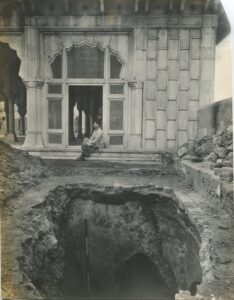
Lahore Fort excavation, unknown artist, private collection.
Pakistan’s case highlights some of the worst aspects of a U.S. policy that has only one solution to propose for cultural loss –halting the circulation of art. In fact, Pakistan does not meet the legal requirements for a U.S. MOU because it has not taken sufficient measures to protect its cultural patrimony and thus fails to meet the CPIA’s self-help requirement. Pakistan’s own domestic policies have done almost nothing to protect its archaeological heritage. Instead, systematized corruption has left museums, historical buildings, and archaeological sites subject to theft, destruction and exploitation for improper commercial usage.
The UNESCO Pakistan Country Strategic Document 2018-2022 discussing Pakistan’s museums puts it mildly:
“a lack of learning resources and trained staff as well as the limited access to digital technologies inhibit the educational role of museums and visitors get little learning experience by visiting. Further, due to limited staff capacity and lack of financial resources many collections do not receive the research and preservation they require.”[2]
With the notable exception the well-curated, professionally organized, and well-displayed collections at the State Bank of Pakistan Museum & Art Gallery in Karachi, Pakistan’s museums lack records and suffer chronic loss of objects through theft, breakage, and replacement with fakes. Museums rarely involve local communities or students and are seen by its government primarily as tourist attractions for foreigners. While there are many dedicated and honorable cultural workers and academics in Pakistan, the government continues to fail them.
Local news reports on monuments and museums in Pakistan reveal numerous instances of malfeasance and neglect.
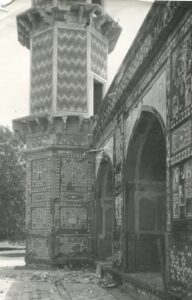
Shalimar Gardens, Lahore, Unknown artist, private collection.
In 2010, after restructuring of heritage management was delegated to local governance in Sindh province, Pakistan’s Dawn newspaper noted that 129 archaeological sites including Moenjodaro, a World Heritage site, had been turned over to the provincial government but that “no steps had been taken.” The Dawn article stated that only months before, a controversy had broken out when the family of the provincial culture minister was accused of digging a waterway across the protected Makli necropolis in Thatta. “The antiquities department had cried itself hoarse but it was not clear whether it had any jurisdiction in the matter.”[3]
Dawn noted in 2010 that “The provincial antiquities draft law is reportedly gathering dust at the Sindh law department, with the result that the newly established antiquities department does not quite know where its jurisdiction crosses paths with the provincial culture ministry.”
In 2012, Dawn reported that at the 17th-century Shalimar Gardens, Lahore, a UNESCO World Heritage site, contractors had reconstructed rather than conserved the walls and buildings, defacing the historical structures. Dawn called for employing conservationists from abroad because Pakistan lacks experts, rather than leaving the ancient buildings to the “whims of building contractors and architects to do as they please with them.”[4]
The world-famous Fasting Buddha excavated in 1894 by Colonel H.A. Dean – called the jewel of the Lahore Museum – was damaged in 2014 after a botched attempt at cleaning and an amateur repair by staffers who filled a crack with prior damage with epoxy. The Lahore National Museum has no conservator and its lab is run by untrained staff.[5]
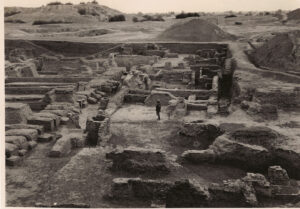
Mound at Harappa, photo 1930s. Private collection.
Exhibits are rarely updated and recent archaeological discoveries go unheralded. The sole exhibition in Pakistan of pre-historic materials from Balochistan was open for only one month in 2015 at the National Museum in Karachi. It was arranged by the German Consulate-General; the Sindh Department of Antiquities and the Islamic Museum in Berlin created the exhibit.[6]
In 2016, Pakistan news media reported that serious irregularities and misconduct including replacement of real antiquities with fakes had come to light in investigations at the Peshawar National Museum. Many coins that were acquired before 1949 had been replaced with replicas and museum staff could not say when this had occurred. The museum had not a single record of the confiscated antiquities it has received from Customs seizures, a category of objects particularly hard hit by theft. “The report noted irregularities in appointment of candidates with no proper background of archeology and mentioned it as one of the main reasons for the missing record,” and said that “the process of replacing original antiques with replicas was supported by bogus documentation.”[7]
Also in 2016, Dawn reported that there was still no clue to the whereabouts of “81 rare antiquities, including the priceless statues of Greek god and goddess, which were ‘stolen’ from the Taxila Museum” in 1999. Police working as security at the museum and the museum’s own guards had accused each other of the theft. (Dawn noted that four years previously, the curator of the Moenjodaro Museum was “terminated from service” after a group of Moenjodaro seals disappeared.) There is still no alarm system at the Taxila Museum.[8]
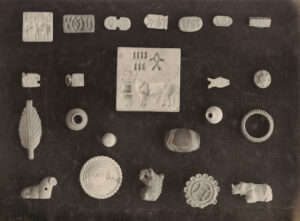
Harappa artifacts, photo 1930s. Private collection.
After over 35 years of local protests, in 2017, Peshawar city authorities finally ordered the destruction of a wedding hall constructed inside the 2,600 year old Gor Khatri Archaeological Complex. The Municipal Corporation Peshawar (MCP) had erected the commercial building on the Gor Khatri land in the early 1980s. According to a report in Pakistan newspaper The News, “There were efforts by the conscientious citizens to have this monstrous structure knocked down but a powerful mafia drawing cash benefits from the building continued to fail them by resorting to various means.”[9]
In 2018, civil society organizations expressed outrage at plans to bulldoze areas of Burnes Gardens, site of the Karachi National Museum. They noted that the government plans (which were abandoned after much protest) could result in severe damage and require emergency removal of the artifacts there, including 56,000 rare coins, 10,000 manuscripts, 4,000 Gandharan artifacts, 50,000 rare images of different sites and 10,000 archaeological artifacts.[10]
The artifacts at the Karachi National Museum had already suffered in prior moves. According to Dawn, a prior transfer of archaeological collections and a valuable library of rare books from storage to the National Museum resulted in significant destruction and loss. Dawn reported:
“There were boxes lying on the dusty floor. It looked like as if someone had packed them in haste…The boxes were lying in the middle of a large room that looked like a badly kept library. It is not. The books are no less valuable than the artefacts. According to the person who was at the branch at the time and did not wish to be named, the books belonged to the federal government. In one corner, one could see broken pieces of pottery. It seems they are part of the materials found by local and foreign archaeologists over the course of their excavations and got damaged while being removed to be transferred to another site.”[11]
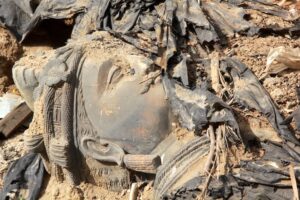
Statues in trash at Karachi National Museum. Photo by Athar Khan.
As late as 2019, there was only one trained art conservator working in Pakistan, primarily on paintings, although he undertook restoration in other media.[12]
The fate of a group of Buddhist antiquities in Pakistan’s museums made headlines five years after they were seized when several large Gandharan stone statues were discovered in a rubbish pile at the National Museum in Karachi. The statues had been recovered from a Pakistani smuggling ring in 2012. (Other Pakistan experts claimed that 90% of the “smuggled” objects were fakes. National Museum staff asserted they were real but would not be harmed by being left outside anyway.) Two of five large statues were used to decorate the doorway of the antiquities director-general’s personal office, the others were tossed into a garbage heap outside. Stated National Museum director Mohammad Shah, “We believe this sculpture dates back 1,500 years and it will be given an original look when we wash it.”[13]
In January 2020, The National newspaper reported that legal action would be taken after a local corporation, the Fatima Fertilizer Co., hired out the 400-year-old royal kitchen of the Lahore Fort for a wedding party, “causing a public outcry after which the Punjab government was forced to take action.”[14] The Lahore Fort is recognized as an endangered monument by UNESCO and listed as a World Heritage Site in Danger. The National stated that, “Pakistan’s Federal Antiquities Act 1975 governs the Lahore Fort and Shalimar Gardens. The Act states that the “protected immovable antiquity shall not be used for any purpose inconsistent with its character or for a purpose other than that directly related to its administration and preservation.” The Lahore Walled Authority, which administers the fort and gardens, initially denied that the event was a wedding party, but videos circulating of the event contradicted them.

Video posted on Twitter of construction workers smashing a Buddhist sculpture in August 2020.
In August 2020, A widely disseminated video posted on Twitter[15] showed construction workers smashing a large Buddhist statue with sledgehammers. The builders encountered the massive stone statue while excavating earth for the foundations of a house being built in Mardan, Khyber Pakhtunkhwa province. The construction workers who smashed the Buddhist statue filmed themselves destroying the ‘idol.’ The contractor was reportedly told by a local cleric that he would “lose his imaan (faith) and his nikah (marriage) will also not remain valid anymore” if the Buddha was not destroyed.[16]
In February 2021, in Mansehra, Khyber Pakhtunkwa province, after repeated complaints by locals, the district administration banned the digging up of graves and tombs by treasure hunters in search of antiquities, saying such activities had not previously come to the attention of the police. A local, Bilal Aman, said that it was a common perception and widely accepted that Hindus buried their gold and other precious goods in fear of theft when they left for India at the time of partition. “The treasure hunters are active in search of such left-over gold and other antiquities,” he said.”[17] Three treasure hunters were arrested the following October.[18]
The request fails to meet legal criteria under the Cultural Property Implementation Act.
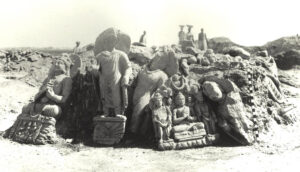
Re-used statues at Sahri-Bahlol, around small stupa iii (From M.A. Stein, ‘Excavations at Sahri Bahlol’, 1912 (courtesy of British Museum, Asia Department)
The Pakistan request is extremely overbroad, covering objects from the Lower Paleolithic period to the mid-20th century.[19] It includes objects from ancient periods for which there is no evidence of an illegal market and ‘ethnographic’ items that continue to be legitimately sold domestically in Pakistan and exported overseas.
There is no evidence that a U.S. market for Pakistan antiquities and ethnographic materials has triggered the current “serious situation of pillage” that would justify a comprehensive blockade.
There is evidence for risk of looting for foreign markets in only a few periods in art from Pakistan, notably that of the Hellenistic and Gandharan periods. However, there are many examples of Gandharan art already in U.S. and European collections made during the last century and Western museums and art dealers already refuse to trade in newly looted items from either Pakistan or Afghanistan, another source for Gandharan art.
Records of seizures of “looted objects’ in Pakistan may be deceptive as much ‘Gandharan’ art offered for sale in Pakistan is fake. For example, after a widely publicized domestic seizure of 395 sculptures in 2012, Pakistani experts determined that “over 90%” were fake, but a Pakistan museum planned to exhibit them anyway as “art.” [20] In 2007, U.S. Homeland Security and Pakistan officials celebrated the return of a “rare Starving Buddha” abandoned in U.S. Customs, as only “the second sculpture of its kind”, but it was quickly identified by a UK art expert as a poor copy of a sculpture in the Lahore Museum.[21] Pakistan officials insisted it was authentic.

Pakistan doors for sale in Santa Fe, NM USA.
Outside of museums, there is little movable Mughal art left of value in Pakistan. Privately owned Mughal artworks were almost entirely removed, primarily by Indian, but also by European and American buyers in the 1960s and early 1970s. Coins and later Islamic materials listed in the proposed restrictions are openly sold to Pakistani and foreign buyers and widely collected in Pakistan itself.
The proposed restrictions include “ethnographic” carpets and textiles.” However, there is no “traditional” or ethnic carpet weaving in Pakistan, all is commercial. Textiles of silk and wool, i.e. carpets and embroideries, are important handicraft industries and have been export commodities and sold widely to tourists for decades in Pakistan.
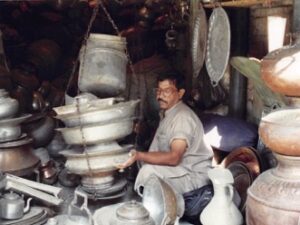
Selling antique tinned copper by the pound, Lahore, photo A. Hale.
Listed ‘ethnographic’ objects such as wood and metalwork are also openly sold in Peshawar, the Swat Valley, Islamabad, and Lahore, and have been lawfully exported to the U.S., U.K. and European countries for decades by the container-load.[22]
Antique and used copper vessels, utensils, and trays are sold by the kilo in Lahore and Peshawar for the price of copper. Old fashioned wedding parties march with these in traditional display but new vessels are considered more prestigious, so most old objects are hammered flat and melted down for sale as scrap.
Finally, Pakistan does not have museum exchange programs or other projects that would meet U.S. requirements for requesting countries to engage in a legal “interchange of cultural property.”[23]
Pakistan’s early laws on antiquities.
Contrary to oft-repeated claims that Pakistan has had national ownership of antiquities since 1975, this is not true.[24] The 1975 law’s primary purpose was to prevent the destruction of monuments by private owners.[25] It restricted export of movable items, requiring a license from the Director of Antiquities (a “temporary export” provision could be granted at the Director’s discretion on placement of a small bond).[26] Still later, the Acquisition of Antiquities Rules 1989 set up a committee to value privately-owned antiquities and set a price for the government to acquire them.[27] Rules for the granting of licenses to antiquities dealers were also established in 1989, together with application forms for licensing.[28]
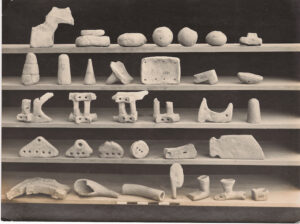
Harappa artifacts from excavation, photo 1930s. Private collection.
The Export of Antiquities Rules, 1979 also provided under Section 3(1)(a) for the “temporary export of an antiquity for the purpose of exhibition, examination or treatment for presentation,” requiring only “a bank guarantee for an amount equivalent to the value of the antiquity as a security for the return of the antiquity to Pakistan.”[29]
Conversely, objects excavated under archaeological permits issued by the Director General of Archaeology were earlier made the property of the Government of Pakistan by the Archaeological Excavation and Exploration Rules 1978.[30]
Pakistan’s 1975 federal antiquities law did not nationalize underground movable heritage until it was amended by the Act No. XXI of 1992.[31]
In 2010, Pakistan delegated all domestic regulation of antiquities to provinces, splintering authority and reducing accountability, funding, and enforcement.
An 18th Amendment to Pakistan’s Constitution was passed on April 8, 2010 that reduced the power of the President and attempted to curb powers and infringements on the Constitution of Pakistan by the military.[32] The enhancement of provincial authority and delegation of formerly federal powers resulted in a significant power shift to provincial assemblies to legislate health, education, women’s and children’s affairs. It also radically altered the administration of cultural heritage in Pakistan by delegating almost all authority over antiquities to the administration of four of Pakistan’s provinces; Balochistan, Khyber Pakhtunkhwa, Punjab and Sindh. (Islamabad Capital Territory is federally administered and Azad Jammu and Kashmir and Gilgit-Baltistan are ‘autonomous territories.’)

Shalimar Gardens, Lahore, Pakistan, unknown artist, private collection.
With these changes, Pakistan’s Ministry of Archaeology and Culture was first subsumed under a ‘Ministry of Culture’, and then placed under the Ministry of Information and Broadcasting.
Supervision of archaeology and cultural heritage legislation (except with respect to Customs export) effectively disappeared from Pakistan’s federal government and was instead vested in the provincial governments. There is still a Director General of the Federal Department of Archaeology (created under a prior 1995 federal law, who sits on the board of the provincial archaeological ministry).
A serious consequence of this administrative fragmentation was that Pakistan now has almost no budget for cultural heritage protection. The annual amount allocated to the Department of Archaeology & Museums in 2020-21 was $346,628, of which two-thirds was for salaries and pensions, leaving $117,120 for all other expenses.
The annual budget estimate for Pakistan’s entire federal National Heritage and Cultural Division for 2020-21 was 1,422,335,000 rupees or $7.7 million at current exchange rates.[33] This budget estimate includes the cost for every form of cultural management including academies, language institutes, grants, monuments, libraries, two national museums, and Pakistan’s contribution to UNESCO and the World Heritage Fund. It also covers the cost of the Lok Virsa, the National Institute of Folk & Traditional Heritage.[34] More than half this amount is for salaries.
The 18th Amendment left each province to pass new heritage laws, establish rules to administer heritage sites and museums, grant excavation permits, and appoint heritage protection and archaeology departments. Antiquities protection was not a top priority. It took six years, from 2010 to 2016, for the Khyber Pakhtunkhwa provincial assembly to adopt a law regulating antiquities excavation, ownership, and trade, superseding the federal 1975 Antiquities Act in all respects except for export.[35]
The devolution of the Archeology and Museums Department of Pakistan, together with the authority held by that department, to the governments of each of Pakistan’s provinces means that antiquities and ethnographic objects on a Designated List must be repatriated to the proper province, as each province now claims sole legal ownership of the antiquities found within it.
The Khyber Pakhtunkhwa Province example.
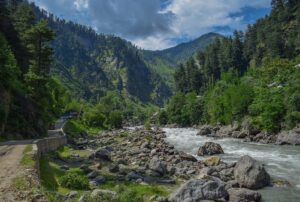
Kunhar River in Khyber Pakhtunkhwa. N15 from Shogran to Naran; Near the Kaghan Valley. Photo by Yousuf Salemwala, 6 July 2017, CCA-SA 4.0 International license.
Khyber Pakhtunkhwa province, a region that includes dozens of nearly inaccessible sites set in high pastures and dramatic mountains, comprises most of the formerly North West Frontier Province (N.W.F.P.)
In 2018, it was merged with the previously Federally Administered Tribal Areas and Provincially Administered Tribal Areas (PATA), thereby consolidating three of the least governable regions of Pakistan.
The Khyber Pakhtunkhwa Antiquities Act of 2016 gives a hint of the potential complications that U.S. authorities could face in repatriating seized goods, which (according to the Act) now explicitly belong to Khyber Pakhtunkhwa and not to the whole of Pakistan. The following is excerpted from the new Khyber Pakhtunkhwa legislation. Note that the term “Government” means the Khyber Pakhtunkhwa provincial government:
-
Retrieval of antiquities from abroad.—
(1) Government shall initiate urgent action for retrieval of antiquities smuggled out of the Province abroad, sold to any person, organization, museum, university or trust.
(2) Directorate shall register FIRs against known or unknown culprits involved or instrumental in the theft, smuggling, trafficking and sale of any antiquity or cultural objects.
(3) For retrieval of smuggled or sold antiquities diplomatic channels as well as assistance of foreign organizations shall be sought by seeking guidance from national and international laws concerning this issue.
(4) Government shall enter into mutual agreements with different governments through the Ministry of Foreign Affairs for return of the smuggled antiquities.
(5) Director shall prepare list of all such antiquities smuggled out of the Province and now on display in different museums abroad or in possession of private collectors or Auctioneers and collect information about their place of origin and other information necessary to prove that the antiquity actually belonged to the Province.[36]
A survey in 2016 reported that more than one hundred archaeological sites have been explored in the adjacent Khyber Agency tribal territory (known as the Federally Administered Tribal Areas (FATA)). This area has been administered by the military since the colonial period, so even police were not allowed entry. By parliamentary decision, the federal Antiquities Act 1975 had not been applied to FATA. Recently, FATA was incorporated into the Khyber Pakhtunkhwa province, making it also subject to the new Khyber Pakhtunkhwa Antiquities Act.[37]
Human rights and cultural rights go together.
Opponents to the Pakistan MOU[38] have noted that despite laws requiring equal protection, Pakistan’s government has turned a blind eye to religious persecution of Christians, Hindus, and Shia Moslem minorities; there are frequent bombings of minority religious institutions and schools.

“Stop Killing Christians” demonstration in Pakistan, Voice of America, no date.
A U.S.-Pakistan cultural property agreement would ignore gross violations of international norms of human and cultural rights in Pakistan. The United States Commission on International Religious Freedom (USCIRF) recommended that the State Department name Pakistan as a “country of particular concern” (CPC), its highest level of concern, in its 2021 Annual Report and is expected to do so again in 2022.[39] The USCIRF stated:
“Pakistan’s religiously discriminatory legislation, such as the blasphemy and anti-Ahmadiyya laws, used in combination with new media rules, contributed to egregious human rights abuses and fostered an overall atmosphere of intolerance for religious minorities that often leads to violence and discrimination.”
“In 2020, there reportedly were 30 Christians, including seven on death row, jailed in Pakistan on charges of blasphemy. They include Asif Pervaiz, a 37-year-old Christian garment factory worker whom a Lahore court sentenced to death in September [2020].”
“The issue of abduction, forced conversion to Islam, rape, and forced marriage remained an imminent threat for religious minority women and children, particularly from the Hindu and Christian faiths. During 2020, USCIRF documented incidents of forced marriages, more than half involving minors… The head of the Parliamentary Committee on Forced Religious Conversions, Senator Anwarul Haq Kakar, claimed that most cases of forced conversion “have some degree of willingness on the part of the girl.”[40]
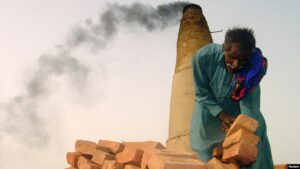
Brickmaking industries in Pakistan commonly utilize slave labor. Voice of America, no date.
International human rights organizations rank Pakistan in the worst ten countries in the Global Slavery Index of 2018,[41] with 3,186,000 people living in slavery.[42]
According to Human Rights Watch, “state practices support [slavery’s] existence,” in which millions of Pakistani citizens live in inescapable debt-bondage, subject to forced labor and rape of women and children, forced marriage and sex trafficking.
The state rarely prosecutes or punishes employers who hold workers in servitude. “Workers who contest their exploitation are invariably confronted with police harassment, often leading to imprisonment under false charges.” HRW reports that Pakistan’s powerful elite are deeply invested in industries such as brick making, sugar, and textiles, where workers are literally locked into debt-bondage lasting multiple generations.[43]
A U.S. MOU would also ignore Pakistan’s cooperation with China in the forced return of Uyghur refugees to face imprisonment, torture, and death, a violation of international law.[44]
Minority heritage destruction.
Minority cultural heritage in Pakistan often suffers as a result of virulent prejudice against minorities. In 2021, the local Hindu community protested the illegal construction of toilets at the buried base of the Shiva lingam at the 3,000 year old Shiv Temple at Mansehra in Khyber Pakhtunkhwa Province.[45] Destruction of minority cultural property is tolerated by higher officials who protest, but not too much. When a Rajput palace in Dera Ismail Khan, Khyber Pakhtunkhwa Province, formerly the home of renowned philanthropist Rai Sahib Das Ram Bagai was demolished by a local politician and real estate dealer, he simply said, ““It was owned by a Hindu…I want to show the Hindu sympathizers that this is now my property. Period.”[46]
While an important Hindu palace apparently cannot receive protection under antiquities laws, the original family residences in Peshawar of two legendary Bollywood stars, Dilip Kumar and Raj Kapoor, are proposed to be turned into museums by the Khyber-Pakhtunkhwa government. The Director of Archaeology of Khyber-Pakhtunkhwa, Dr. Abdul Samad Khan, announced that both houses had been declared national heritage sites and both would be turned into museums.[47]
Corruption as a way of life.
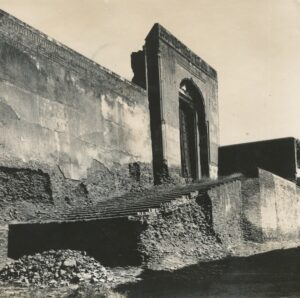
Lahore Fort, unknown artist, private collection.
‘Pak’ means pure or clean. At its founding Pakistan was intended to be a ‘clean’ state operating under Islamic law. The vision of its founder, Muhammad Ali Jinnah, a former barrister trained at Lincoln’s Inn in London, was that East and West Pakistan would be an alternative to living under a Hindu-majority, secular state of independent India.
Jinnah’s Presidential Address delivered to Pakistan’s first Constituent Assembly denounced bribery and corruption as “one of the biggest curses from which India is suffering.” He urged the delegates to “tackle this monster, which today is a colossal crime against society,” and always to be guided by principles of justice and complete impartiality.
Yet for decades past Pakistan’s government has been one of the most corrupt in the world.[48]
Critics of the proposed MOU argue that endemic corruption, from the highest to the lowest levels of government in Pakistan, is a factor that renders Pakistan incapable of satisfying the criteria set by Congress in the CPIA at this time. Pakistan’s extreme domestic corruption renders its laws ineffective. A country where regulations – from site protection to preservation of archives and artifacts in museums, to laws banning export of antiquities – are deliberately ignored cannot meet Congressional criteria for import restrictions under the CPIA.
Pakistan is a 70 year old, nominally-democratic state that holds elections, however flawed. It has a highly bureaucratized governing system. It has a large body of laws, many inherited from India’s colonial past, but it is not a country in which laws govern society.
Despite its system of laws, Pakistan’s government functions on a daily basis through payoffs for doing ordinary, legitimate work as well as for cutting corners, or for criminal actions – and its bureaucracy punishes those who cannot afford to or will not pay. Bribes flow upward through a system of patronage to higher and higher levels of government.[49] In exchange, higher officials reward lower echelon participants with support in the form of job security regardless of competence, legal immunity from complaints of abuse, and carte blanche to enrich themselves by many times their official salaries every year. In practice, this system nullifies all Pakistan’s laws against conflict of interest, bribery, and money laundering, and weakens insider trading and tax evasion laws.[50] It has an enormous impact on the ability of Pakistan’s government to provide for the health and security of its citizens, fossilizing corrupt practices as necessary sources of income for mid- and low-level bureaucrats and draining the country’s economy on a massive scale. For example, under the second Benazir Bhutto administration, corruption was estimated to “cost the Pakistani economy between 20-25% of its 1996-1997 GDP.”[51]
How is Pakistan’s “corruption system” relevant to whether the U.S. signs an MOU with it?
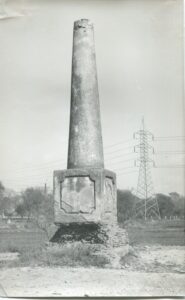
Kos Minar, medieval marker on the Grand Trunk Road. Photo by unknown artist, private collection.
An MOU must be effective in order to be justified under US law. It is not required to completely cure the problems of neglect and destruction and looting of heritage, but it IS required to have an effect. For this to happen, Pakistan’s government must truly be committed to preserving its heritage.
The 2020-2021 UNESCO Pakistan Country Strategic Document acknowledges Pakistan’s failure to document its heritage inventories, enforce domestic laws, or provide funding for heritage protection – as well as the need to educate its citizens to value cultural heritage:
“An effective implementation of the 1970 Convention requires the inventorying and registration of both public and private collections as well as the updating of relevant legislations to regulate the illegal art and antiquity market. A lack of public awareness about the issue, combined with limited financial resources, lack of technical capacity of law enforcement agency, and inadequate coordination with key cultural institutions, continues to prevent the regulation of the trade of cultural properties and contribute to the low implementation of the 1970 Convention.”[52]
This analysis raises serious questions whether Pakistan would or could honor a cultural property agreement by checking looting, documenting damage and destruction to heritage, or taking the self-help measures it has so far failed to employ.
Congress placed procedural and substantive constraints on the executive authority to impose import controls under the CPIA. Under the aegis of the State Department’s Bureau of Educational and Cultural Affairs, import restrictions under the CPIA have provided for near permanent bans on the import of virtually all cultural items from the prehistoric to the present time from the countries which have sought agreements. If CPAC fails to heed the concerns of Congress regarding overbroad import restrictions and requiring evidence of meeting the four determinations, CPAC acts in derogation of U.S. law and against the best interests of the people of the United States.
What can be done to preserve heritage in Pakistan?

Kos Minar, Ghari Sahu, medieval marker on the Grand Trunk Road. Photo by unknown artist, private collection.
The Department of State should instead provide expertise through grant aid and assistance to Pakistan’s now-fragmented cultural authorities. It should work with them and with Pakistan’s federal officials to build a cultural infrastructure that will expand protections within that nation. Given Pakistan’s current state of cultural heritage management, this could do far more to safeguard heritage than an MOU that will have no domestic effect.
The Department of State should also acknowledge the public’s interest in an effective cultural policy by publishing the substance of source country requests together with factual analyses of existing cultural policy by the foreign government. Neither Pakistan’s request nor any other government’s request has been made public for the last twenty years of CPAC’s operation at State.
Yet other State Department sections publish reports and analyses dealing with human rights, religious freedom and other matters essential to developing U.S. public policy. These are often highly critical of foreign governments but their publication does not result in weakening of U.S. security or breaches in foreign relations. Greater transparency at the Bureau of Educational and Cultural Affairs would strengthen, not weaken U.S. cultural policy.
See the Committee for Cultural Policy’s full Testimony to the Cultural Property Advisory Committee: 2022-04-19 CCP GHA Testimony to CPAC on Pakistan Request
[1] Request from the Government of the Islamic Republic of Pakistan Under Article 9 of the 1970 UNESCO Convention on the Means of Prohibiting and Preventing the Illicit Import, Export and Transfer of Ownership of Cultural Property, Federal Register Notice April 25, 2022, (Volume 87, Number 65, Page 19724).
[2] UNESCO Pakistan Country Strategic Document 2018-2022, at 15, https://en.unesco.org/sites/default/files/ucsd.pdf
[3] Sindh Antiquities Act, Dawn, April 8, 2010, https://www.dawn.com/news/846074/sindh-antiquities-act.
[4] Historical Monuments, Dawn, February 29, 2012, https://www.dawn.com/news/699308/historical-monuments.
[5] Shoaib Ahmed, ‘Fasting Buddha’ damaged during cleaning, Dawn, June 26, 2014, https://www.dawn.com/news/1115168
[6] Anil Datta, An exposition of pre-historic pottery from Balochistan, The News, https://www.thenews.com.pk/print/237131-Demolition-of-wedding-hall-in-historical-Gor-Khatri-startshttps://www.thenews.com.pk/print/74228-an-exposition-of-pre-historic-pottery-from-balochistan
[7] Inquiry report points out irregularities in Peshawar Museum, The News, May 20, 2016, https://www.thenews.com.pk/print/121255-Inquiry-report-points-out-irregularities-in-Peshawar-Museum
[8] Amjad Iqbal, No clue to antiquities stolen in 1999, Dawn, March 25, 2016, https://www.dawn.com/news/1247824/no-clue-to-antiquities-stolen-in-1999
[9] The News Bureau, Demolition of wedding hall in historic Gor Khatri starts, The News, October 17, 2017,
[10] Civil society perturbed over likely demolition of National Museum, The News, August 21, 2018, https://www.thenews.com.pk/print/357875-civil-society-perturbed-over-likely-demolition-of-national-museum
[11] Peerzada Salman/Bhagwandas, Precious artefacts get damaged, others face risk of theft during shifting, Dawn, July 5, 2015, https://www.dawn.com/news/1192345
[12] Iqra Sarfaraz, Preserving art, You magazine, The News, https://www.thenews.com.pk/magazine/you/549832-preserving-art. The conservator, Zubair Ahmed Madani works at the National Museum in Karachi and also takes private clients.
[13] Hafeez Tunio, 1,500 year old statues left in the trash at National Museum, Express Tribune, November 17, 2017, https://tribune.com.pk/story/1560429/1-1500-year-old-statues-left-trash-national-museum
[14] Wedding event at Lahore Fort causes public outcry, The News, January 10, 2020, https://www.thenews.com.pk/latest/596558-wedding-event-at-lahore-fort-causes-public-outcry
[15] https://twitter.com/arifaajakia/status/1284306652364144641
[16] Kate Fitz Gibbon, Smashing Buddhas in Pakistan: Rural Ignorance and Museum Indifference, Cultural Property News, August 15, 2020, https://culturalpropertynews.org/smashing-buddhas-in-pakistan-rural-ignorance-and-museum-indifference/
[17] ‘Treasure hunters’ dig up old grave in Mansehra, The News, February 3, 2021, https://www.thenews.com.pk/print/784337-treasure-hunters-dig-up-old-grave-in-mansehra
[18] Three treasure hunters held, The News, October 7, 2021, https://www.thenews.com.pk/print/898246-three-treasure-hunters-held
[19] CPAC’s administrators notified the public of the scope of the proposed MOU by placing the following on the ECA website: “The Government of Pakistan seeks import restrictions on archaeological and ethnological material from the Lower Paleolithic, Mesolithic, Neolithic, Chalcolithic, Bronze Age, Iron Age, Historic Pre-Muslim Period, Early Muslim Period, Mughal, Sikh, and Colonial periods through the creation of Pakistan. Requested archaeological material includes, but is not limited to, stone; ceramics; metal objects including coins; stucco/plaster; glassware; bone, ivory, shell, and horn; manuscripts, paintings, proclamations, deeds, books, and documents; textiles of silk, wool, leather; and wood, dating from the lower Paleolithic (2 million years before present) through the first half of the twentieth century A.D. Requested ethnological material includes, but is not limited to stone; ceramics; metal objects including coins; stucco/plaster; glassware; bone, ivory, shell, and horn; manuscripts, paintings, proclamations, deeds, books, and documents; textiles of silk, wool, leather, and wood objects both architectural and moveable objects; and wooden objects dating from the Pre-Muslim Historic period through the first half of the twentieth century A.D.”
[20] Gandhara Relics: Seized artifacts fake, but ‘pieces of art’ to still get museum display, The Express Tribune, August 31, 2012, regarding a seizure of 395 sculptures, 90% of which were replicas. https://tribune.com.pk/story/429285/gandhara-relics-seized-artefacts-fake-but-%E2%80%98pieces-of-art%E2%80%99-to-still-get-museum-display
[21] Martha Lufkin, Starving Buddha sculpture returned to Pakistan, The Art Newspaper, February 26, 2007, https://www.theartnewspaper.com/2007/03/01/starving-buddha-sculpture-returned-to-pakistan
[22] Pakistan is a major source of supply for architectural wood. Photographs are attached taken April 17, 2022 of the outside inventory of a store in Santa Fe, comprising both Indian and Pakistani wood architectural elements. Nota bene: Experienced ethnographers know that the so-called Nuristani, “Kafir” and Pashai wood items now available are copies, not authentically old. This was the case even 30 years ago.
[23] One Buddhist sculpture lent to Switzerland, the only loan of Pakistan art in recent years, does not equal a significant “interchange of cultural property.” Pak, Swiss ties ‘strengthened’ as ancient Buddha sculpture sent from Peshawar to Zurich, December 13, 2018, https://www.thenews.com.pk/latest/405418-pakistan-loans-ancient-budha-monument-to-switzerland
[24] See Appendix 2, Act VII of 1976, Antiquities Act, 1975. This law explicitly repealed The Antiquities Act, 1968 (XIV of 1968), and the Antiquities Ordinance, 1975 (XX of 1975).
[25] Antiquities Act 1975, Section 15(i): “If the Federal Government apprehends that a protected immovable antiquity is in danger of being destroyed, injured or allowed to fall into decay, it may, after consultation with the Advisory Committee, direct the Provincial Government to acquire such antiquity or any part thereof; and the Provincial Government shall thereupon acquire such antiquity or part under the Land Acquisition Act, 1894 (I of 1894), as for a public purpose.
[26] The 1975 Act provided for private ownership of sites and monuments, termed “antiquities”, for compensation to owners for any damage by the government, and for the government to take ownership only if no owner could be located (Sections 2(k)(iv.-v.), 11, 12(ii)(g), 28). Restrictions could be placed by a private owner on usage. The government could also take guardianship of an “antiquity” under an agreement with the private owner (Section 12). Government preemption of an antiquity placed for sale required payment to the owner or dealer of the object or site’s fair market value.
[27] The Acquisition of Antiquities Rules 1989 established pursuant to Article 37 of the Antiquities Act, 1975 (VII of 1976), created an Acquisition Committee made up of “eminent historians, archaeologists, linguists and specialists in numismatics, epigraphy, ethnography, calligraphy, and paintings” to establish the purchase price for government acquisition. Acquisition of Antiquities Rules 1989, pages 25-26.
[28] Among other responsibilities, licensed dealers were required to maintain registers for purchases and sales, and “to inform all customers that export of antiquities outside Pakistan is completely banned except as provided in the Act and the Export of Antiquities Rules, 1979.” Id. at Subsection Dealing in Antiquities Rules 1989, page 29.
[29] Id. at Subsection Export of Antiquities Rules 1979, pages 34-35.
[30] Compiled by Muhammad Rafique Mughal, Legislations for the Protection and Management of Archaeological Heritage of Pakistan, Subsection Archaeological Excavation and Exploration Rules 1978, pages 16-21, available at https://en.unesco.org/sites/default/files/pakistan_legislation_07_1995_engl_orof.pdf.
[31] The 1992 Amendment added a section #13A providing that “Ownership of buried antiquities – Notwithstanding anything contained in any other law for the time being in force, the ownership of all buried antiquities shall vest in the Federal Government.” The 1992 Amendment gave the Director General of the Antiquities Department the ability to determine compensation for preemption of an antiquity instead of the independent valuation required under the 1975 Act. However, even after 1992, monuments, historic sites, and above ground archaeological remains were privately owned. See Act No. XXI of 1992.
[32] Eighteenth Amendment to the Constitution of Pakistan, Wikimedia, https://en.wikipedia.org/wiki/Eighteenth_Amendment_to_the_Constitution_of_Pakistan#:~:text=The%20Eighteenth%20Amendment%20of%20the,semi%2Dpresidential%20to%20a%20parliamentary. The 18th Amendment turned Pakistan from a semi-presidential to a parliamentary republic, renamed the N.W.F.P as Khyber Pakhtunkhwa,
[33] Budget Estimates 2020-2021 National Heritage & Culture Division (Demand No.056), https://heritage.pakistan.gov.pk/SiteImage/Misc/files/BudetEstimates2020-21.pdf
[34] Id.
[35] Nisar Mahmood, KP Assembly passes Antiquities Bill 2016, The News, March 30, 2016, https://www.thenews.com.pk/print/108985-KP-Assembly-passes-Antiquities-Bill-2016.
[36] https://kpcode.kp.gov.pk/uploads/THE_KHYBER_PAKHTUNKHWA_ANTIQUITES_ACT_2016.pdf
[37] Rafiullah Khan, Carving history, The News, December 25, 2016, https://www.thenews.com.pk/tns/detail/562363-carving-history. Article 247 (3) of the constitution pronounced inapplicability of laws enacted by the parliament to FATA. It is only applicable through presidential ordinance. There is no archaeological department in FATA.
[38] Opponents included the Committee for Cultural Policy and Global Heritage Alliance.
[39] Annual Report of the U.S. Commission on International Religious Freedom, USCIRF, April 2021, at 2, https://www.uscirf.gov/sites/default/files/2021-04/2021%20Annual%20Report_0.pdf
[40] The report gives the example of Myra Shahbaz, a 14-year-old Christian schoolgirl, was abducted at gunpoint. Despite Myra telling police she was drugged, raped, and forced to sign papers her abductor later used to allege that she was 19 and had voluntarily married and converted, the court ordered that she be returned to her abductor.” Id. at 36. https://kpcode.kp.gov.pk/uploads/THE_KHYBER_PAKHTUNKHWA_ANTIQUITES_ACT_2016.pdf, § 52.
[41] Modern Day Slavery in Pakistan, Courting the Law, February 13, 2020, https://courtingthelaw.com/2020/02/13/commentary/modern-day-slavery-in-pakistan/; See also Life of slavery — the perpetuation of bonded labor in Pakistan, DW, December 25, 2019, https://www.dw.com/en/life-of-slavery-the-perpetuation-of-bonded-labor-in-pakistan/a-51792298.
[42] Global Slavery Index, Pakistan https://www.globalslaveryindex.org/2018/data/maps/#prevalence
[43] Contemporary Forms of Slavery in Pakistan, Human Rights Watch, July 1995Library of Congress Catalog Card Number: 95-77876, SBN 1-56432-154-1, https://www.hrw.org/reports/1995/Pakistan.htm#:~:text=Although%20slavery%20is%20unconstitutional%20in,who%20hold%20workers%20in%20servitude
[44] Brent E. Huffman, Pakistan Is Cracking Down on Uyghur Muslims Who Fled China, Pulitzer Center, May 21, 2021, https://pulitzercenter.org/stories/pakistan-cracking-down-uyghur-muslims-who-fled-china
[45] Arshad Aziz Malika, Illegal construction at Mansehra temple irks Hindus, June 9, 2021, The News, Pakistan, Hindu Affairs Deputy Secretary Faraz Abbas denied receiving any complaint. The archaeology department is insisting that all old buildings be handed over to it. https://www.thenews.com.pk/print/846783-illegal-construction-at-mansehra-temple-irks-hindus
[46] Ehtesham Hassan, Palace Intrigue, April 17, 2021, The News, https://www.thenews.com.pk/tns/detail/821732-palace-intrigue. Das Ram built schools and colleges in the region and set up free dispensaries as well as tuberculosis wards in local hospitals. He built embankments on the Indus, to protect the city from flooding. The archaeology department of Khyber-Pakhtun-Khwa said it would do nothing, claiming that the building (actually built 125-150 years ago) was only 92 years old and must be 100 years old to qualify for protection.
[47] Arshad Aziz Malik, Converted into museums: Govt officials visit Dilip Kumar, Raj Kapoor houses today, The News, September 30, 2020, https://www.thenews.com.pk/print/722379-converted-into-museums-govt-officials-visit-dilip-kumar-raj-kapoor-houses-today
[48] Transparency.org, Pakistan scores a low 28 for 2021 on a zero to 100 scale, ranking 140th out of 180 countries in the world. A score below 50 indicates serious corruption. https://www.transparency.org/en/cpi/2021/index/pak
[49] Funds generated through corrupt, criminal activities are a primary support for political candidates. The highest levels of government are fully aware of the scope of corruption. The former Chief Executive’s Benazir Bhutto’s spouse was popularly known as “Mr. Ten Percent,” taking a cut on all government purchases in her first term of office and “Mr. Twenty Percent” in her second term. While claiming that the country was nearly bankrupt, and demanding massive infusions of foreign aid, top politicians have hidden millions and even billions of the money collected through excess profits and bribes in off-shore banks and high value real estate in foreign countries and even taken objects from museums to decorate their foreign residences.
[50] A number of sources detail how hierarchy facilitates and reinforces corrupt practices. See Nasir Islam, Sifarish, sycophants, power and collectivism: administrative culture in Pakistan, International Review of Administrative Sciences, June 1, 2004, https://doi.org/10.1177%2F0020852304044259 and Feisal Khan (2007) Corruption and the Decline of the State in Pakistan, Asian Journal of Political Science, 15:2, 219-247, DOI: 10.1080/02185370701511644 A useful compilation of international press reports covering both domestic corruption and international entanglements (such as found in the Panama Papers) is entitled “Pakistan in Focus: Political Corruption at its Peak: The Challenge for Judicial Activism,” by Dr. Wazir Ali Khan, 2018.
[51] Feisal Khan (2007) Id. at 224, citing Burki, S. J. (1999). Pakistan: Fifty Years of Nationhood, 3rd edn. Boulder: Westview Press, 174, 178.
[52] UNESCO Pakistan Country Strategic Document 2018-2022, 14, https://en.unesco.org/sites/default/files/ucsd.pdf
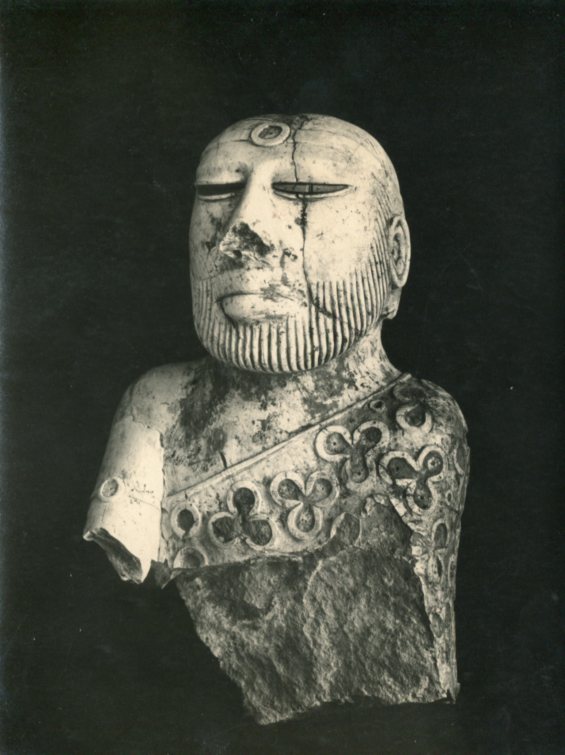 Moenjodaro sculpture, photo 1930s. Private collection.
Moenjodaro sculpture, photo 1930s. Private collection. 

